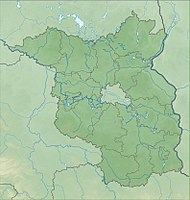Mountains of cats
|
Mountains of cats
|
||
| location | Heidesee , Dahme-Spreewald district , Brandenburg , Germany | |
| surface | 144 ha | |
| Identifier | 1547 | |
| WDPA ID | 329481 | |
| Natura 2000 ID | DE3848304 | |
| FFH area | 141.23 hectares | |
| Geographical location | 52 ° 12 ' N , 13 ° 44' E | |
|
|
||
| Setup date | June 25, 2004 | |
| administration | State Environment Agency Brandenburg (Department of Ecology, Nature Conservation, Water) | |
| Legal basis | Directive 92/43 / EEC | |
The Katzenberge nature reserve is located in the municipality of Heidesee in the Dahme-Spreewald district in Brandenburg . It belongs to the Dahme-Heideseen nature park .
The area with the identification number 1547 was placed under nature protection by ordinance of May 28, 2004 . The approximately 144 hectare nature reserve extends northeast of Neubrück , a residential area of the community of Groß Köris . The Schmöldesee extends to the northwest and the Holzerne See to the west . The B 179 runs to the west and the Dahme , a tributary of the Spree , flows to the east . The Dubrow and Radeberge nature reserves extend a little to the west and the Streganzsee-Dahme NSG to the east .
natural reserve
Natura 2000 and FFH areas
The NSG Katzenberge is part of the coherent European ecological network of special protection areas Natura 2000 . The profile of the Federal Agency for Nature Conservation (BfN) contains the following characterization for the 141.23 hectare FFH area under the number 3848-304:
“Closed forest area with a high proportion of structurally rich oak forests on moraine sites. Profile of the FFH area Katzenberge. "
Flora and fauna
plants
Among the habitat types, the FFH profile lists the following plant and forest communities : Old acidic oak forests on sandy soils with English oak (Natura 2000 code 9190) and subcontinental, base-rich sand lawns (6120; Koelerion glaucae ).
Animals
According to Annex II of the Flora-Fauna-Habitat Directive and the ordinance of the state, including their habitats, which are important for reproduction, nutrition, migration and wintering, are particularly protected: among the invertebrates, the great ibex ( Cerambyx cerdo ) and the stag beetle ( Lucanus cervus ) .
See also
Individual evidence
- ↑ a b c 3848-304 Katzenberge. (FFH area) Profiles of the Natura 2000 areas. Published by the Federal Agency for Nature Conservation . Retrieved May 19, 2020.
Web links
- World Database on Protected Areas - Katzenberge (English)
- Ordinance on the “Katzenberge” nature reserve of May 28, 2004 on bravors.brandenburg.de, accessed on May 19, 2020
- Katzenberge on the website of the Dahme-Heideseen Nature Park

